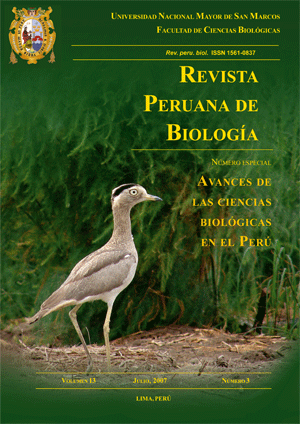Ecology of the diurnal lizards community in the Reserva Nacional de Paracas, Ica, Peru
DOI:
https://doi.org/10.15381/rpb.v13i3.2334Keywords:
Saurians, Tropiduridae, use of resources, Reserva Nacional de Paracas, PeruAbstract
In present paper we study some ecological aspects of the diurnal saurian community of National Reserve of Paracas (RNP) since April to September 1999.”. The spatial distribution, habitat uses (spatial niche), activities patterns (temporal niche) and the diet (trophic niche) of these reptiles were analyzed with the objective of identifying the main differences that will allow a division in the use of the resources. Ctenoblepharis adspersa (bigheaded lizard), Microlophus peruvianus (beach lizard), M. theresiae (dune lizard) and M. thoracius icae (grass lizard) were the species studied. Each lizard showed preference for some particular habitat, to exception of M. peruvianus that was present in all the habitats. The activity was concentrated to the half-day, to exception of C. adspersa. The diets were mainly insects. Differences in trophic, temporal and spatial niche were observed and these would facilitate the coexistence in sympatry of species lizards.Downloads
Downloads
Published
Issue
Section
License
Copyright (c) 2006 José Pérez Z, Katya Balta

This work is licensed under a Creative Commons Attribution-NonCommercial-ShareAlike 4.0 International License.
AUTHORS RETAIN THEIR RIGHTS:
a. Authors retain their trade mark rights and patent, and also on any process or procedure described in the article.
b. Authors retain their right to share, copy, distribute, perform and publicly communicate their article (eg, to place their article in an institutional repository or publish it in a book), with an acknowledgment of its initial publication in the Revista Peruana de Biologia.
c. Authors retain theirs right to make a subsequent publication of their work, to use the article or any part thereof (eg a compilation of his papers, lecture notes, thesis, or a book), always indicating its initial publication in the Revista Peruana de Biologia (the originator of the work, journal, volume, number and date).






